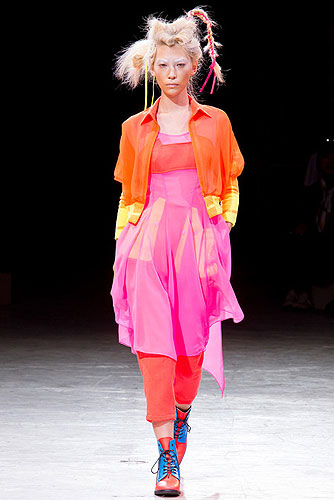
















































After his tour de force collection of last season, it appears that Yohji Yamamoto is now gleefully back with a vengeance.
www.cbamd.comParisFashion WeekFashion Brand
After his tour de force collection of last season, it appears that Yohji Yamamoto is now gleefully back with a vengeance.
After his tour de force collection of last season, it appears that Yohji Yamamoto is now gleefully back with a vengeance. If that last show was something of a "greatest hits" with the freshest of spins, this season is a varied selection of hits to come. The new spirit that is possessing Yamamoto is timely. If there are two designers whose oeuvres are being looked at by many others this season, it is Yohji Yamamoto's and Issey Miyake's. And now Yamamoto is showing them how it is done in the present.
The mood was rebellious once more. A recurring theme seems to be emerging in Paris this season, with designers going against the grain and challenging preconceived notions of themselves, particularly by flirting with a sense of "bad taste." Yamamoto was no different. His silhouettes might have started with a delicate study of the shoulder in his beloved black—here the structure was softened, with tailored jacket sleeves barely held by bows, chains, threads, and cord—but all of a sudden, there was a full-frontal assault of flouro. Yes, flouro: a complete look of layered pink, yellow, red, and orange with turquoise and red boots to match.
In the eighties, Yamamoto and Comme des Garçons were seen as the cool, black antidote to the decade's Day-Glo nonsense, and here the designer is embracing it wholeheartedly and happily in great swaths of this collection. As Yamamoto's PR pointed out, somewhat aghast, the inspiration of Harajuku girls was also involved in parts. That's something this designer would never normally look at. "This collection's private title is Meaningless Excitement," said Yamamoto after his show, laughing mischievously.
And perhaps Mischievous Excitement might be a more public title for this collection, because Yamamoto transformed the trendy and transitory into something a bit more substantial: In its fresh use of flouro; in those casually abstracted layered looks; the architectural slatted structures; the digitized camo prints on chiffon tailoring; the terrific, perverse knitwear; the bell-meets-kimono-sleeve shirtdresses—there is, in short, much to choose from. The collection came to an end with lights flicked off, one by one, and the focus on a gang of girls in white shirts and black skirts, worn with the rough-and-tumble attitude of the British comprehensive school uniform. The separated sleeves were back from the beginning, this time without their jackets. In anyone else's hands, all of this might have looked tricky; in Yamamoto's, it just felt so fresh and easy.
When asked after his show whether he was in a rebellious mood, Yamamoto replied, "Yes, I am. And I hate doing something that I refer to in fashion as déjà vu. For this collection I made so many trials of cutting, playing on the shoulder, the strips, the fresh neon color…so many trials. And it was something I needed to do!" When it was pointed out that not many designers could get away with presenting so many varied things with such skill in a collection, Yamamoto responded, in a theatrical stage whisper, "That's because I'm genius!" He was joking, of course, but the thing is, he kind of is just that.